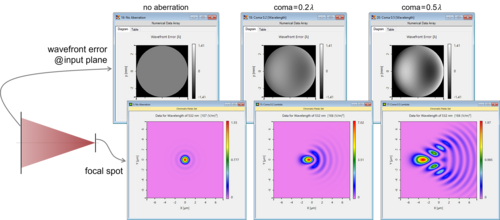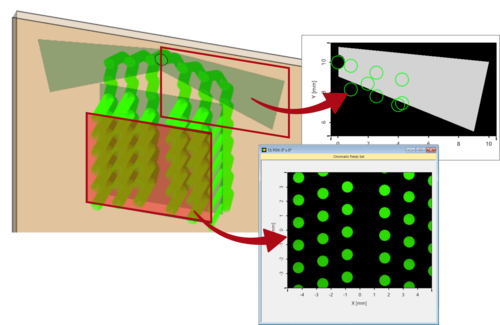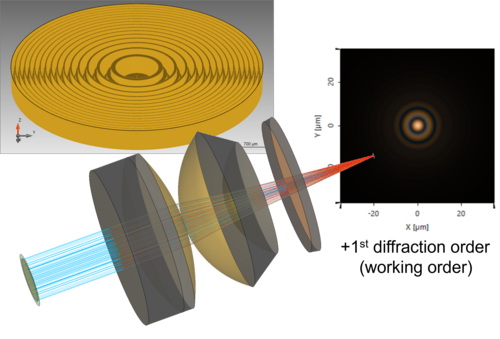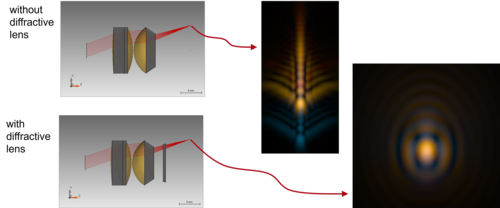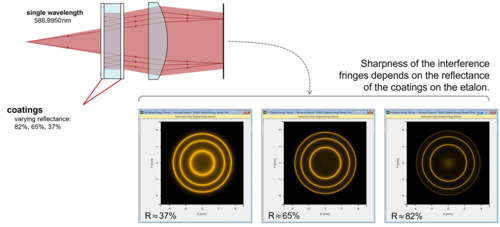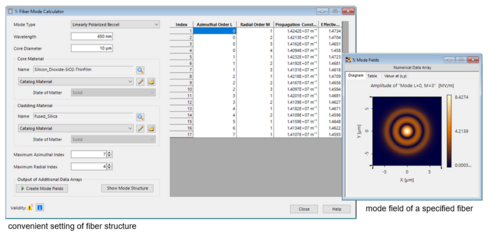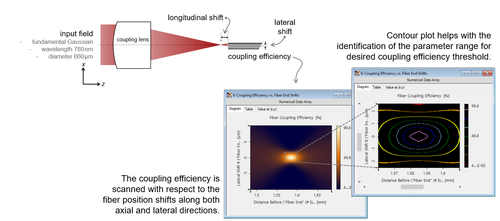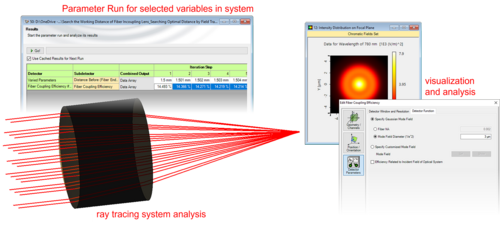What’s new in our Optical Modeling and Design Software?
Aberrations in Optical Imaging Systems
The main functionality of an imaging system is to gather as much of the light emanating from each of the object points as possible, and to make those cones of light converge again at the image plane, so that each object point is mapped univocally to its counterpart in the image plane. The performance of such systems is generally judged on the basis of how well this correspondence between object and image points is maintained, with the well-known theoretical limit imposed by the phenomenon of diffraction: even in an optical system that, according to the laws of geometrical optics, will map all the rays coming from one object point exactly to a single, mathematical, image point, diffraction will cause that image point to smear into a small, but finite-sized, spot. This diffraction-limited situation is what the design of an imaging system typically aims for, with the diffraction-limited field having a spherical wavefront. Geometrical deviations from this spherical wavefront are known as “aberrations”, and are characterized using different polynomial bases that help quantify their strength and shape. The presence of aberrations will increase the smearing of the image spot and consequently decrease the quality of the imaging system.
With the fast physical optics software VirtualLab Fusion aberration effects can be studied well. For this week’s newsletter, we have selected two examples related to aberrations: the first, of how the typical wavefront aberrations affect the pattern in focus of a spherical wave, and the second, of how the astigmatism of a high-power laser diode influences performance in the focal region. Using the free space propagation field solver and the Local Plane Interface Approximation (LPIA), diffraction, polarization and vectorial effects that can potentially degrade an image can all be included in the investigation.
Read moreSimulation of Lightguide-Based AR & MR Systems
Most common designs of augmented and mixed reality (AR & MR) systems incorporate lightguide designs with surfaces that contain micro- and nanostructured regions (gratings) for coupling and pupil expansion purposes. Many of the complex effects which influence the final quality of the device (for example, crucial aspects like how good the uniformity is in the eyebox for the different field-of-view modes that describe the digital image) have their roots in physical optics: polarization (initially of the source, as well as how the polarization changes as the light propagates through the device), coherence, diffraction, etc.
With its Light Guide Toolbox, the fast physical optics software VirtualLab Fusion provides the optical engineer with all the necessary tools to tackle the modeling and design of this type of device. To demonstrate its capabilities we showcase here two examples of simulations of different AR & MR setups.
Read moreInvestigation of Real-Structure Grating Effects
Gratings are some of the fundamental optical components used in many different modern applications and technologies. These components can sometimes be modeled with sufficient accuracy by functional approaches. However, for a thorough study of the effects that a grating introduces into an optical system, a modeling strategy that takes into account the actual structure is required.
VirtualLab Fusion offers a broad range of different specialized solvers for this task, ranging from approximate but fast methods like the Thin Element Approximation (TEA), to rigorous approaches like the Fourier Modal Method (FMM)/Rigorous Coupled-Wave Analysis (RCWA).
In this week's newsletter we showcase two examples that illustrate these solvers in action, playing their role in examples taken from various fields of application.
Read moreHybrid Lens Design for Correction of Aberrations
Hybrid lenses combine the advantages of classic refractive components and diffractive structures, and hence have become a promising approach in different optical applications. In particular, the opposite signs of the dispersion for refractive and diffractive surfaces enable the correction of chromatic aberrations.
In order to model and design such a hybrid element accurately, the in-depth analysis of diffraction effects through the system is a necessity. VirtualLab Fusion’s fast physical optics propagation techniques allow for the accurate modeling of classic lenses and calculation of the diffraction efficiencies of the different orders of a diffractive lens.
To illustrate the capabilities of the software in this regard, we compare the models of a refractive and hybrid eyepiece. In this example, the propagation of light and the corresponding chromatic effects are investigated for on-axis as well as off-axis beams at different wavelengths.
Read moreNon-Sequential Modeling Etalons and Fabry-Pérot Resonators
Optical etalons are utilized in various applications, for example in the field of spectroscopy and laser resonators. The basic configuration of an etalon just comprises a plan-parallel transparent plate and can form a well-known Fabry-Pérot resonator, which is usually used for spectral and/or angular selection.
VirtualLab Fusion’s non-sequential field tracing technique enables the accurate modeling of very different types of etalons, with either planar or curved surfaces in combination with high-reflective coatings. Further, the physical-optics modelling approach automatically includes vectorial effects and hence allows for the investigation of polarization effects on the interference pattern.
As a typical application, we demonstrate the optical setup for the examination of sodium D lines with an etalon as the key component.
Read moreLinearly Polarized (LP) Fiber Modes
To conclude our series on fiber modeling, this week we introduce another set of tools that VirtualLab Fusion makes available to its users in this field. With the help of the linearly polarized (LP) Fiber Mode Calculator it is possible to generate and investigate the Bessel and Laguerre polynomials that describe the fiber modes propagating in multimode step- or graded-index fibers respectively.
The associated LP Mode source can be employed in combination with the Multiple Light Source to configure a finite set of these modes as the light source in an optical system, which would emulate the field exiting a given fiber. This enables the simulation of how the field exiting the fiber will propagate through the rest of a complex system and be transformed by it.
To showcase the capabilities of these features, we have selected, alongside a use case that covers the LP Fiber Mode Calculator in more detail, another example that demonstrates how a certain combination of aberrations deforms the shape of the modes emanating from our fiber source.
Read moreTolerance Analysis of Fiber-Coupling Systems
In our last newsletter we put the spotlight on the parametric optimization of a fiber-coupling setup to achieve maximum efficiency, employing the user-friendly tools put at your disposal by the fast physical optics modeling and design software VirtualLab Fusion. However, a good optical design in practice is not just characterized by the optimum combination of parameters that can maximize a specific merit function. Another key aspect is its robustness: as the conditions assumed in the design process cannot be perfectly met in a real-life environment, the logical next step is to analyze how small deviations in the system geometry influence the overall result.
For this purpose, the Parameter Run in VirtualLab Fusion allows the user to perform parameter sweeps. As an example, we analyze the coupling efficiency of a well-designed fiber-coupling lens with respect to different tolerance factors, such as the lateral shift of the fiber-end position and the tilt of the coupling lens. Furthermore, a deep-dive into the scanning mode for the parameter run, in which a two-dimensional area of the parameters space is investigated (with additional possibilities for the visualization of the results), is provided below.
Read moreFiber Coupling Optimization
Fibers are some of the most versatile components in modern optics. One of their most valued characteristics is their capacity to transport optical energy with very low losses over very long distances. On the flip side, coupling light into a fiber in a way that achieves as high an efficiency as possible is often a very delicate endeavor: selecting the right optical components for the coupling and aligning the system well are, among others, fundamental steps to ensure a satisfactory coupling efficiency.
The fast physical optics modeling and design software VirtualLab Fusion enables its users to simulate and optimize core components such as the incoupling lenses, in order to design the coupling system and analyze its performance and robustness. As an introduction to this topic, in this week’s newsletter, we demonstrate two examples where the working distance and the incoupling lens are optimized using VirtualLab Fusion’s Parameter Run and Parametric Optimization tools to increase the coupling efficiency of a single-mode fiber almost to 100%.
Read more



